Basic Geometry Formulas
Introduction
Geometry is the math that studies shapes, sizes, and properties of objects and spaces. Whether you’re building a house, designing a beautiful rangoli, or simply curious about the world around you, understanding basic geometry is essential. In this guide, we explore fundamental geometric formulas that are as easy as enjoying a cup of chai. From finding the area of your farm to calculating the perimeter of your ancestral home, these formulas simplify complex concepts into practical tools. So, let’s dive into the world of triangles, circles, and squares, where every formula has a story waiting to be unraveled. Embrace the magic of geometry, where mathematics meets art, and discover the beauty of shapes in your everyday life.
Table of Contents for Basic Geometry
1. Area of a Square
Formula: \(\text{Area} = \text{side}^2\)
Example: If the side of a square is 5 units, the area is \(5^2 = 25 \, \text{square units}\)
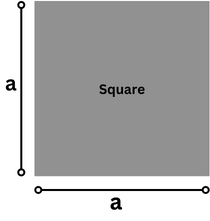
2. Perimeter of a Square
Formula: \( \text{Perimeter} = 4 \times \text{side} \)
Example: If the side of a square is 6 units, the perimeter is \(4 \times 6 = 24 \, \text{units}\)
3. Area of a Rectangle
Formula: \( \text{Area} = \text{length} \times \text{width} \)
Example: If the length is 8 units and width is 3 units, the area is \(8 \times 3 = 24 \, \text{square units}\)

4. Perimeter of a Rectangle
Formula: \( \text{Perimeter} = 2 \times ( \text{length} + \text{width} ) \)
Example: If the length is 7 units and width is 4 units, the perimeter is
\(2 \times (7 + 4) = 22 \, \text{units}\)
5. Area of a Triangle
Formula: \( \text{Area} = \frac{1}{2} \times \text{base} \times \text{height} \)
Example: If the base is 6 units and height is 9 units, the area is
\( \frac{1}{2} \times 6 \times 9 = 27 \, \text{square units} \)

6. Perimeter of a Triangle
Formula: \( \text{Perimeter} = \text{side1} + \text{side2} + \text{side3} \)
Example: If the sides of a triangle are 4 units, 5 units, and 7 units, the perimeter is \(4 + 5 + 7 = 16\) units.
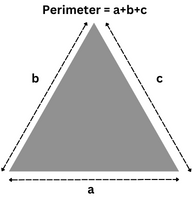
7. Area of a Circle
Formula: \( \text{Area} = \pi \times \text{radius}^2 \)
Example: If the radius is 3 units, the area is \(\pi \times 3^2 = 9\pi = 28.269\) square units.

8. Circumference of a Circle
Formula: \( \text{Circumference} = 2 \times \pi \times \text{radius} \)
Example: If the radius is 4 units, the circumference is
\( 2 \times \pi \times 4 = 8\pi = 25.128 \, \text{units} \)

9. Area of a Trapezoid
Formula: \(\text{Area} = \frac{1}{2} \times (\text{sum of parallel sides}) \times \text{height}\)
Example: If the parallel sides are 5 units and 7 units, and the height is 10 units, the area is
\(\frac{1}{2} \times (5 + 7) \times 10 = 60 \text{ square units}\)
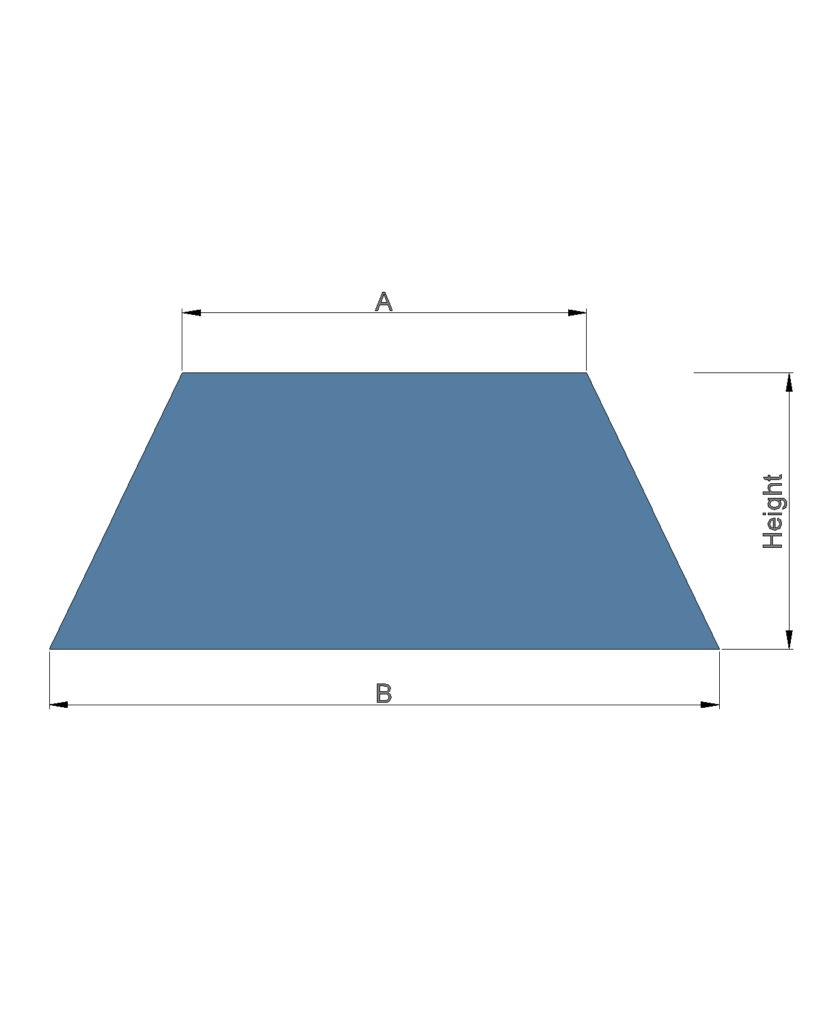
10. Volume of a Trapezoid Prism
Formula: \( \text{Volume of Trapezoid Prism} = \frac{h}{3} \left( A_1 + A_2 + \sqrt{A_1 \cdot A_2} \right) \)
Where,
A1 = Base Area, A2= Top Area, h= Height of Prism
Question: How much water can a trapezoidal prism-shaped container hold, given that its base has a length of 4 meters, width of 2.5 meters, the top has a length of 2.5 meters, width of 1.75 meters, and the height is 2.5 meters?
Solution: Given that L1= 4 m.
B1= 2.5m. , L2= 2.5m. , B2= 1.75m. , h= 2.5m.
\( \text{Base Area(A1)} = L_1 \times B_1 = 4.0 \times 2.5 = 10 \, \text{m}^2 \)
\( \text{Top Area (A2)} = L_2 \times B_2 = 2.5 \times 1.75 = 4.375 \, \text{m}^2 \)
\( \text{Volume of Container} = \frac{h}{3} \left( \text{A1} + \text{A2} + \sqrt{\text{A1} \times \text{A2}} \right) \)
\( =\frac{2.5}{3} \left(10 + 4.375 + \sqrt{10 \times 4.375}\right) = 17.491 \, \text{m}^3\)
Further we know that \( 1 \, \text{m}^3 \, \text{of water} = 1000 \, \text{liters of water}\)
so \(17.491 \, \text{m}^3 \, \text{water} = 17.491 \times 1000 = 17491 \, \text{Litter Water}\)

11. Volume of a Cube
Formula: \( \text{Volume} = \text{side}^3 \)
Example: If a cube has sides of length 4 units, the volume is
\(4^3 = 64 \text{ cubic units}\)
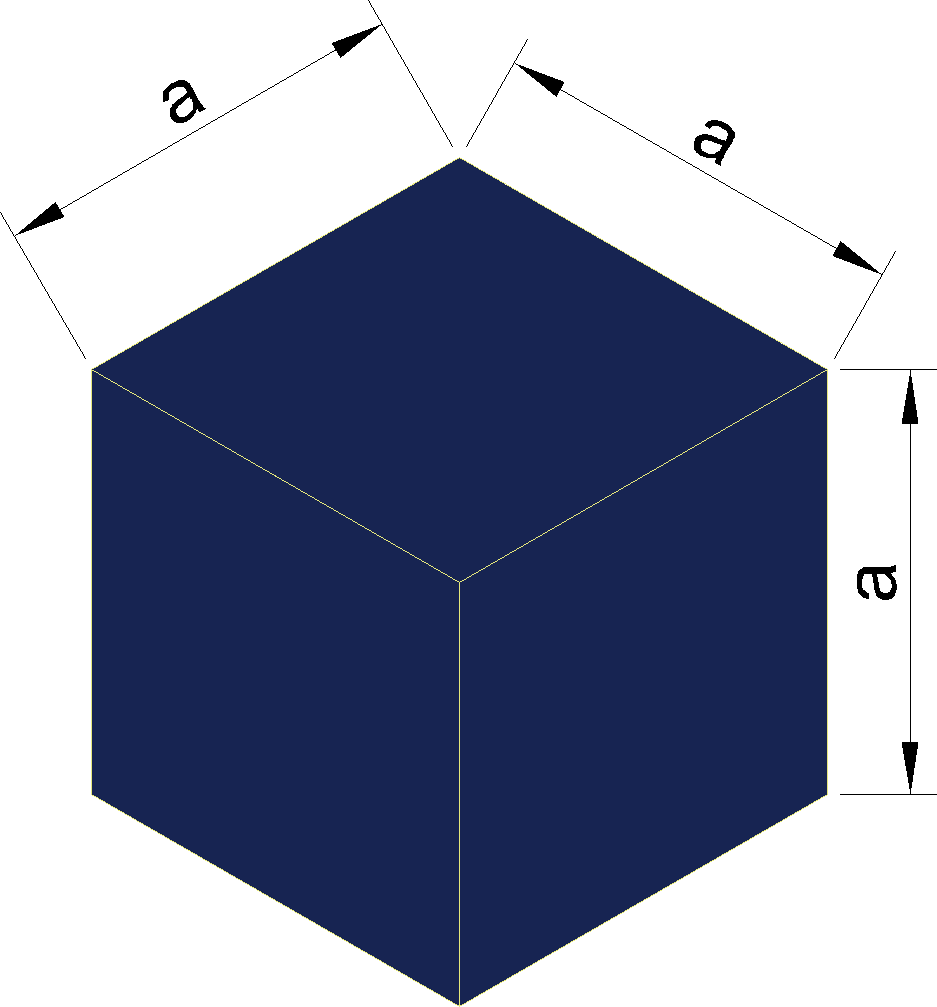
12. Surface Area of a Cube
\( \text{Surface Area of Cube} = 6a^2\)
Question : Hameed has built a cubical water tank with lid for his house, with each outer edge 1.5 m long. He gets the outer surface of the tank excluding the base, covered with square tiles of side 25 cm, find how much he would spend for the tiles, if the cost of the tiles is Rs.360 per dozen.
Solution :
Edge of the cubical tank = 1.5 m = 1500 mm (= a)
So, \( \text{Surface Area of the Tank} = 5 \times 1500 \times 1500 \, \text{mm}^2 \)
\(\text{Area of each square tile} = \text{side} \times \text{side} = 250 \times 250 \, \text{mm}^2\)
So, \( \text{The Number of Tiles Required} = \frac{\text{Surface Area of the Tank}}{\text{Area of Each Tile}}\)
\(=\frac{(5 \times 1500 \times 1500)}{(250 \times 250)} = 180 \text{ Nos.} \)
Cost of 1 dozen tiles, i.e., cost of 12 tiles = Rs.360
Therefore, \(\text{cost of one tile} = \frac{\text{Rs.360}}{12} = \text{Rs.30}\)
So, \( \text{the cost of 180 tiles} = 180 \times \text{Rs.30} = \text{Rs. 5400} \)
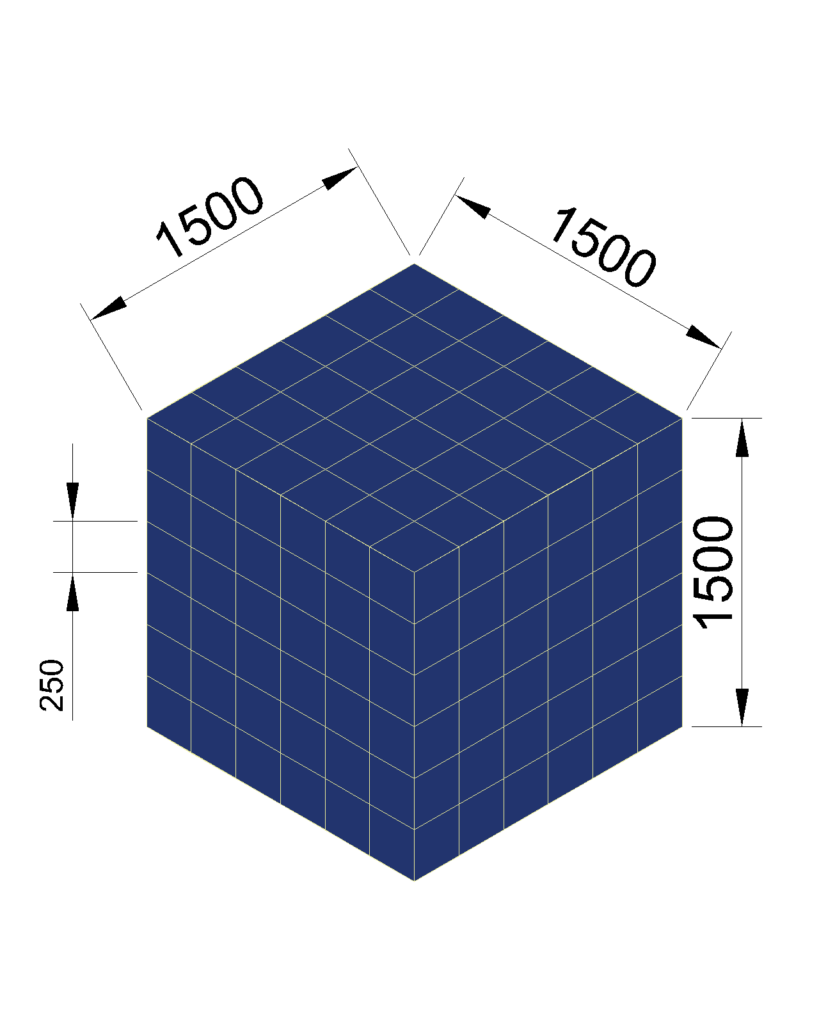
13. Surface Area of a Cuboid
Formula: \( \text{Surface Area of Cuboid} = 2(lb + bh + hl) \)

For example, if we have a cuboid whose length, breadth and height are 15 cm, 10 cm and 20 cm respectively, then its surface area would be:
\(2 \left[(15 \times 10) + (10 \times 20) + (20 \times 15) \right] \, \text{cm}^2\)
\( = 2(150 + 200 + 300) \, \text{cm}^2 \)
\(= 2 \times 650 \, \text{cm}^2 = 1300 \, \text{cm}^2\)
14. Volume of a Cuboid
Formula: \( \text{Volume of a Cuboid} = \text{Length} \times \text{Breadth} \times \text{Height} \)
Question: A wall of length 10 m was to be built across an open ground. The height of the wall is 4 m and thickness of the wall is 24 cm. If this wall is to be built up with bricks whose dimensions are 24 cm × 12 cm × 8 cm, how many bricks would be required?
Solution : Since the wall with all its bricks makes up the space occupied by it, we need to find the volume of the wall, which is nothing but a cuboid.
Here, \( \text{Length} = 10 \, \text{m} = 1000 \, \text{cm} \)
Thickness = 24 cm & Height = 4 m = 400 cm
Therefore, \( \text{Volume of the wall} = \text{length} \times \text{thickness} \times \text{height}\)
\(\ = 1000 \times 24 \times 400 \, \text{cm}^3 \)
Now, each brick is a cuboid with Length = 24 cm, Breadth = 12 cm and Height = 8 cm
So, \( \text{Volume of each brick} = \text{length} \times \text{breadth} \times \text{height}\)
\(= 24 \, \text{cm} \times 12 \, \text{cm} \times 8 \, \text{cm}^3 \)
So, \( \text{{Number of Bricks Required}} = \frac{{\text{{Volume of the Wall}}}}{{\text{{Volume of Each Brick}}}}\)
\( = \frac{{1000 \times 24 \times 400}}{{24 \times 12 \times 8}} = 4166.6 \)
So, \(\text{The Wall Requires 4167 Bricks.}\)
15. Surface Area of a Right Circular Cylinder
\( \text{Surface Area} = \text{Perimeter of Cylinder Base } \times h = 2\pi rh \)

Question: Savitri had to make a model of a cylindrical kaleidoscope for her science project. She wanted to use chart paper to make the curved surface of the kaleidoscope. What would be the area of chart paper required by her, if she wanted to make a kaleidoscope of length 25 cm with a 3.5 cm radius? You may take π = 22 /7 .
Solution: Radius of the base of the cylindrical kaleidoscope (r) = 3.5 cm.
Height (length) of kaleidoscope (h) = 25 cm.
Area of chart paper required = curved surface area of the kaleidoscope =
\(2\pi rh = 2 \times \frac{22}{7} \times 3.5 \times 25 = 550 \, \text{cm}^2\)
16. Volume of Cylinder
Volume of a Cylinder \( (V) = \pi r^2 h \)

17. Surface Area of a Right Circular Cone
\( \text{Surface Area of Circular Cone} = \pi r l \)
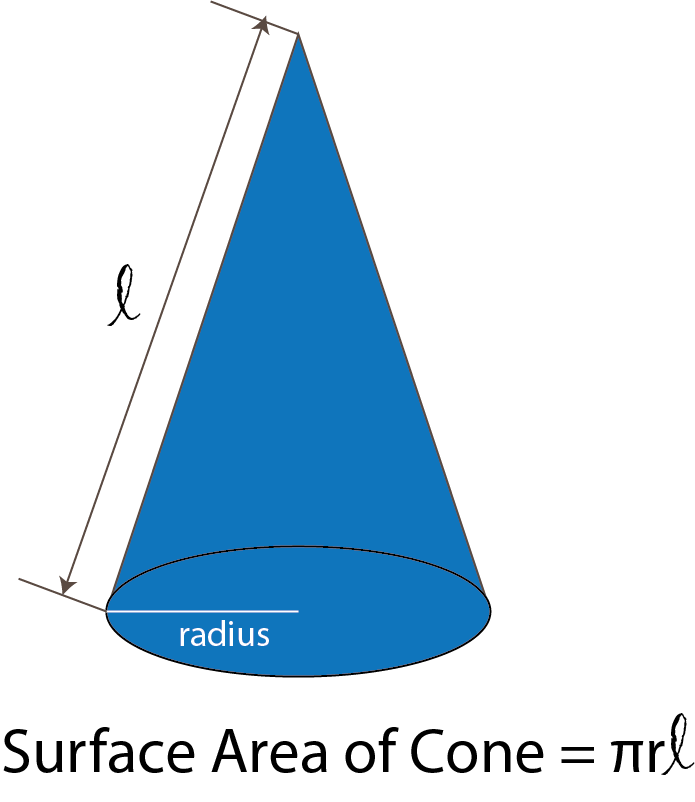
Question: The height of a cone is 16 cm and its base radius is 12 cm. Find the curved surface area and the total surface area of the cone (Use π = 3.14).
Solution : Here, h = 16 cm and r = 12 cm.
So, from \( l = \sqrt{h^2 + r^2} \), we have
\( l = \sqrt{16^2 + 12^2} = \sqrt{400 \, \text{cm}^2} = 20 \, \text{cm} \)
So, \(\text{Curved Surface Area} = \pi r l\)
\(= 3.14 \times 12 \times 20 \, \text{cm}^2 = 753.6 \, \text{cm}^2\)
Further, \( \text{Total Surface Area} = \pi rl + \pi r^2 \)
\( = (753.6 + 3.14 \times 12 \times 12) \, \text{cm}^2 \)
\(= (753.6 + 452.16) \, \text{cm}^2 = 1205.76 \, \text{cm}^2 \)
18. Volume of a Cone
Formula: \( \text{Volume of Cone} = \frac{1}{3} \pi r^2 h \)
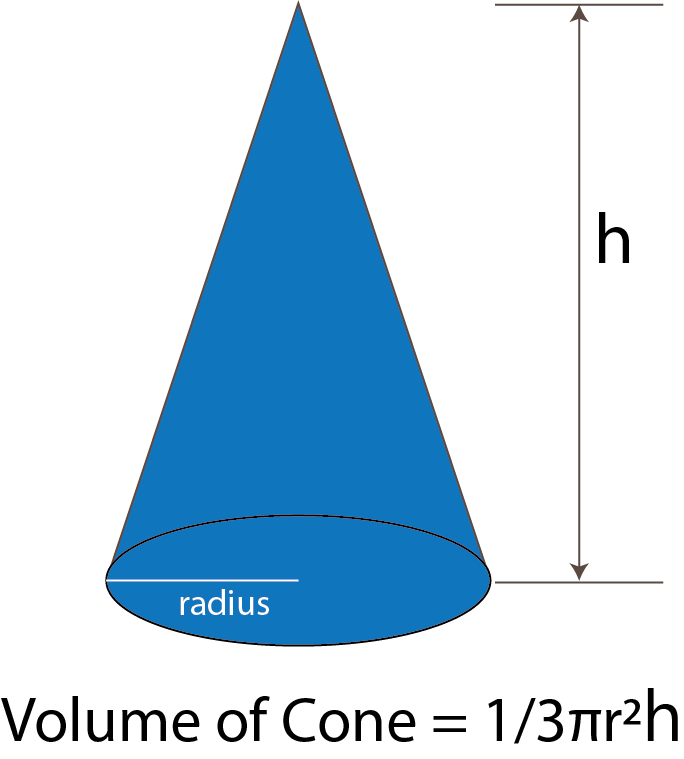
19. Surface Area of a Sphere
Formula: \( \text{Surface Area of a Sphere} = 4 \pi r^2 \)

Question: The hollow sphere, in which the circus motorcyclist performs his stunts, has a diameter of 7 m. Find the area available to the motorcyclist for riding.
Solution : Diameter of the sphere = 7 m. therefore, radius is 3.5 m.
So, the riding space available for the motorcyclist is the surface area of the ‘sphere’ which is given by
\(4\pi r^2 = 4 \times \frac{22}{7} \times 3.5 \times 3.5 \, \text{m}^2 = 154 \, \text{m}^2\)
20. Volume of a Sphere
Formula: \( \text{Volume of a Sphere} = \frac{4}{3} \pi r^3 \)
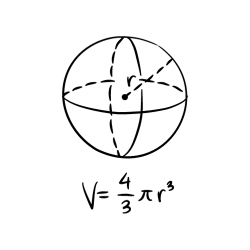
Question: A shot-putt is a metallic sphere of radius 4.9 cm. If the density of the metal is 7.8 g per cm3 , find the mass of the shot-putt.
Solution : Since the shot-putt is a solid sphere made of metal and its mass is equal to the product of its volume and density, we need to find the volume of the sphere.
Now, \( \text{Volume of the sphere} = \frac{4}{3}\pi r^3 \)
\(=\frac{4}{3} \times \frac{22}{7} \times 4.9 \times 4.9 \times 4.9 = 493 \, \text{cm}^3 \, (\text{nearly}) \)
Further, mass of 1 cm3 of metal is 7.8 g.
Therefore, mass of the shot-putt = \( 7.8 \times 493 \, \text{g} = 3845.44 \, \text{g} = 3.85 \, \text{kg} \, (\text{nearly}) \)
21. Surface Area of Hemisphere
Formula: \( \text{Surface Area of Hemisphere} = 2 \pi r^2 \)

Question: A hemispherical dome of a building needs to be painted. If the circumference of the base of the dome is 17.6 m, find the cost of painting it, given the cost of painting is Rs. 5 per \(100 \, \text{cm}^2.\)
Solution : Since only the rounded surface of the dome is to be painted, we would need to find the curved surface area of the hemisphere to know the extent of painting that needs to be done.
Now, circumference of the dome = 17.6 m. Therefore, \( 17.6 = 2\pi r \)
So, \( \text{the radius of the dome} = \frac{{17.6 \times 7}}{{2 \times 22}} = 2.8 \, \text{m} \)
The curved surface area of the dome \(= 2\pi r^2 = 2 \times \frac{22}{7} \times 2.8 \times 2.8 \, \text{m}^2 = 49.28 \, \text{m}^2\)
Now, cost of painting 100 cm2 is Rs.5.
So, cost of painting 1 m2 = Rs.500
Therefore, cost of painting the whole dome = Rs. 500 × 49.28 = Rs.24640
22. Volume of a Hemisphere
Formula: \( \text{Volume of a Hemisphere} = \frac{2}{3}\pi r^3 \)
Question: A hemispherical bowl has a radius of 3.5 cm. What would be the volume of water it would contain?
Solution : The volume of water the bowl can contain
\( \frac{2}{3}\pi r^3 = \frac{2}{3} \times \frac{22}{7} \times 3.5 \times 3.5 \times 3.5 = 89.8 \, \text{cm}^3 \)
Summary
\begin{align*} 1. & \text{ Area of Square:} \quad A = a^2 \\ 2. & \text{ Perimeter of Square:} \quad P = 4a \\ 3. & \text{ Area of Rectangle:} \quad A = \text{Length} \times \text{Width} \\ 4. & \text{ Perimeter of Rectangle:} \quad P = 2(\text{Length} + \text{Width}) \\ 5. & \text{ Area of Triangle:} \quad A = \frac{1}{2} \times \text{Base} \times \text{Height} \\ 6. & \text{ Perimeter of Triangle:} \quad P = a + b + c \\ 7. & \text{ Area of Circle:} \quad A = \pi r^2 \\ 8. & \text{ Circumference of Circle:} \quad C = 2\pi r \\ 9. & \text{ Area of Trapezoid:} \quad A = \frac{1}{2} (\text{Sum of Parallel Sides}) \times \text{Height} \\ 10. & \text{ Volume of Trapezoid Prism:} \quad V = \frac{h}{3}(A_1 + A_2 + \sqrt{A_1 \times A_2}) \\ 11. & \text{ Volume of Cube:} \quad V = a^3 \\ 12. & \text{ Surface Area of Cube:} \quad SA = 6a^2 \\ 13. & \text{ Surface Area of Cuboid:} \quad SA = 2(lb + bh + hl) \\ 14. & \text{ Volume of Cuboid:} \quad V = \text{Length} \times \text{Width} \times \text{Height} \\ 15. & \text{ Surface Area of Right Circular Cylinder:} \quad SA = 2\pi rh \\ 16. & \text{ Volume of Cylinder:} \quad V = \pi r^2 h \\ 17. & \text{ Surface Area of Right Circular Cone:} \quad SA = \pi r\ell \\ 18. & \text{ Volume of Cone:} \quad V = \frac{1}{3}\pi r^2 h \\ 19. & \text{ Surface Area of Sphere:} \quad SA = 4\pi r^2 \\ 20. & \text{ Volume of Sphere:} \quad V = \frac{4}{3}\pi r^3 \\ 21. & \text{ Surface Area of Hemisphere:} \quad SA = 2\pi r^2 \\ 22. & \text{ Volume of Hemisphere:} \quad V = \frac{2}{3}\pi r^3 \\ \end{align*}






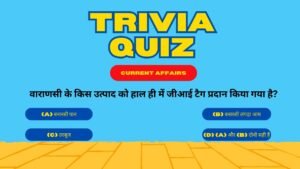

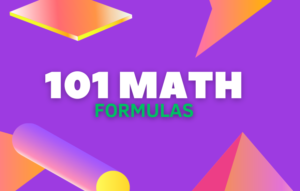
I’m extremely impressed with your writing skills as well as with the layout on your blog.
Is this a paid theme or did you modify it yourself? Either way keep up the nice quality writing, it’s rare to see a nice blog like this
one these days.
I have used the Generate Press Premium Theme and customized it according to our preferences. Additionally, I’ve applied some extra CSS codes
Terrific article! This is the type of info that are meant
to be shared across the internet. Shame on the search engines for no longer positioning this submit
higher! Come on over and visit my website . Thank you =)
Howdy would you mind letting me know which web host you’re using?
I’ve loaded your blog in 3 different browsers and I must say this blog loads a lot faster then most.
Can you suggest a good web hosting provider at a fair price?
Thank you, I appreciate it!
You can buy the best and most affordable hosting plan through my referral link ” https://hostinger.in?REFERRALCODE=1ASKCONSULT44 “